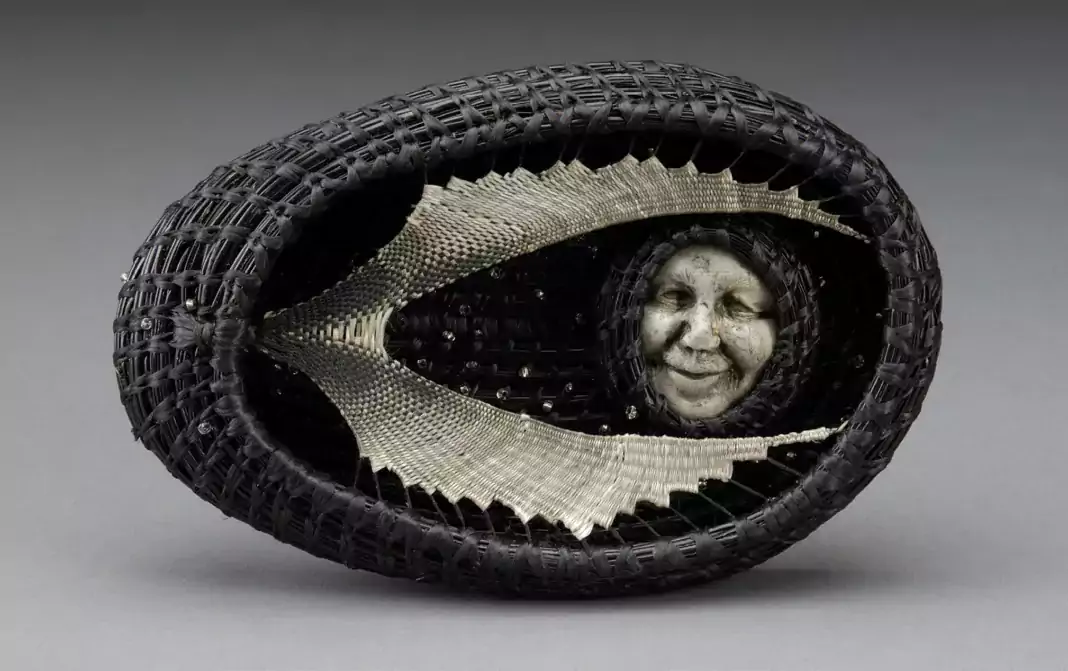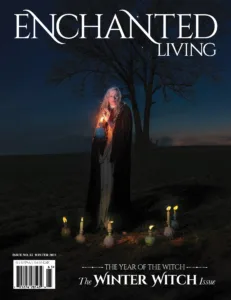Photography by Ronald L. Sowers
Baskets exist to store, to carry, to hold. Sometimes they contain day-to-day, imminently practical objects; sometimes they capture what’s far more elusive: thoughts, memories, joys, even a touch of melancholy. The basket may well hold the essence of its weaver or some wildness and wisdom from the spirit of the tree from which it came. Perhaps on occasion, a heartfelt incantation has been woven into a basket’s undulating rows of pine and sinew. It’s even possible that a slender ray of moonlight can become trapped within its tangles and never quite escape, even with the rising of the sun.
Pamela Zimmerman’s creations transcend into the mysteriously sublime. In her “Catching the Moon” series, Teneriffe lace is woven into webs atop soulful faces peering out from below. One might ask if it’s they who caught the moon, or if the moon entranced and ultimately caught them.
Kambriel: When were you first drawn to the ancient yet constantly evolving craft of basket weaving?
Pamela Zimmerman: I’ve always loved baskets and have especially been drawn to Native-style baskets, particularly coiled ones. Living and working in northern Arizona as a National Park ranger before I ever made a basket, I studied and bought Native American baskets and wished I could make something like them.
K: How has being based in North Carolina—with its long, rich tradition of basket weaving and roots in Cherokee, Gullah, and European cultures—inspired your work?
PZ: I love all forms of indigenous baskets from around the world. They are constantly inspiring. I’ve lived here for over thirty years, and North Carolina’s influence has really been in the availability of materials: There is so much that grows well here—longleaf pine needles, which I have used extensively, and also the fabulous array of weedy things people don’t want that are easy to find in abundance, like vines (honeysuckle, Virginia creeper, wisteria, kudzu, English ivy), yucca, and dandelions. Free and available materials have always been essential to the basket maker, who uses what they have; this is the tradition of all Native people’s basketry.
K: Did this diverse array of cultures have a special impact or provide inspiration for your own particular style or techniques?
PZ: I’ve been inspired to see how the cultures that came before made baskets with what they had access to. It is something I have pondered and preached throughout my time as a basket maker and teacher. Most tribes altered their basketry forms, sometimes quite dramatically, to appeal to Europeans when this continent was invaded by white men. Many things we consider typical of a certain tribe were adopted as “traditional” forms by that tribe in recent historical memory. I can give many examples: the Coushatta pine-needle baskets, as well as the Tohono O’odham coiled-yucca and devil’s-claw baskets. Even the Cherokee have begun to make pine-needle baskets, though there is no record of pine-needle baskets existing in that culture until relatively recently. The whole Gullah basket tradition is driven by the historic atrocity of cultural displacement by slavery. They combined their skills from Africa with what they could find in the New World to make what they needed and generated a whole new heritage. All these cultures have influenced me in that they are taking what they have and making what they need, whether it be to have something to sell or to winnow grain.

K: At what point did you feel yourself coming into your own, experimenting beyond traditional basketry toward the realm of personal creative expression?
PZ: I’ve experimented from the very beginning in my basketry journey. I learned my first technique, coiling, from Judy Mallow’s From Forest Floor to Finished Project, but I struck out and did things my own way, the way they worked for me. Coiling lends itself very well to ad lib. It’s the easiest basketry technique, in my opinion, because it has only two active elements. After coiling alone for several years, I found the North Carolina Basketmakers Association and started going to their annual convention, where I took and taught my first classes. I selected classes for the techniques they contained as opposed to the basket we were weaving, for the sole purpose of adding techniques to my repertoire.
It took a long time to think I had come into my own. One curator said, “If you can do this”—a finely woven piece— “why in the world would you want to do that?”—a rustic weaving. One artist told me that if I did not make one style recognizably mine, I would always appear as a student. The implication is that the process of exploration and discovery is only for those who are unlearned. That is sad as well as wrong. Look at great creators in history who did not focus: Leonardo, Picasso, Michelangelo. They were not criticized for dabbling in too many media.
Why was it wrong for me to explore as many directions as I wished? I finally resolved this question within myself. People want relationships between things when they are presented together. I generally explore a new idea at least three times before I am ready to move on, though often the first rendering remains my favorite. So I give the appearance of focus while my creativity remains at large, actively seeking new, challenging, exciting avenues of applying my store of techniques I collect along the way. Why is this important? I have learned another secret. I always heard of people hitting creative walls, running out
of ideas. I could never comprehend this. It doesn’t seem possible for me to not have an idea or something to work on. The secret lies in the fact that I have not focused. When you choose to work only in one direction, when the project is finished, of course there is nothing else to do. I freely explore whatever comes to my fancy. I am an artist because I must be; curiosity and creativity is a compulsion. If I cannot have fiber, it will be expressed another way: in the teaching of my children, making my unconventional dinner, or watercolor. It will emerge, nonetheless. I am here and have come into my own.
K: Basketry can strike a perfect balance between the utilitarian and artistic. Is striking such a balance a goal in your own pieces?
PZ: Utility is important only when I am making a particular thing I need. The rest of the time it is all art. I imagine early man, painting on a cave wall. The woman was over here figuring out how to weave a sandal from a yucca plant or something. He’s over there, indulging himself in something purely decorative, making handprints on the wall or documenting his fabulous hunt: the beginning of painting art. She is figuring out how to make something out of what she has found, something to make life easier: the beginning of fiber art. Eventually, she
will also make it beautiful, but there is so much to figure out about making it work first. Painting has always been decorative. Fiber was about making something you needed. Both of these transcend and become art when creativity is employed and whatever is made evokes emotion. Whatever the medium, art is accomplished when the mundane is transformed into the thought provoker.
I consider myself a fiber artist and prefer to work in a sculptural context. Once a year, my family takes a vacation on a remote rural property, where I try to weave with what I can find in the woods: twigs, barks, vines, grasses. At these times, I sometimes try to make useful baskets. It feels like I’m an ancient Native woman when I sit in the creek and weave with my children playing nearby. I often feel like I am the first basket maker, trying to figure out how to make a vessel with what I have around me. It’s a wonderful, primal experience and never fails to enrich my perspective as an artist.
K: You created a series entitled “Catching the Moon.” Does the moon hold special significance for you?
PZ: The “Catching the Moon” series was an outgrowth of my face baskets, the first of which was a gift for one of my children’s teachers. It was very emotional, putting that face in the basket. I’m still trying to figure it out. Faces attract us. The faces draw people in who would not otherwise look at a woven piece. I have been told by some other artists that faces are wrong in baskets. As far as I’m concerned, that is as good a reason as any to keep making them! But many of my weaving ideas come in the middle of the night, and that is how the “Catching the Moon” series started, when one of my children was not sleeping well. Lots of nights. Lots of moons. Even after he started sleeping better, there were more moons. They all had something different to say. The middle of the night is like that.
K: As this issue’s theme is “Winter Witch,” whatdo you personally consider to be some of the most magical and meaningful aspects of the winter season?
PZ: Winter is the time when we contemplate endings. It seems everything is ending and yet, it does not. The leaves come back. The birds return. Baby animals are born. All of that is magical. The older I get, the harder it is not to revisit the comparisons of life to the seasons of the year. I am in winter now, and it is good.
K: Do you find yourself weaving any particular thoughts, feelings, or wishes into the baskets?
PZ: But of course! The feel of a finished work is imbued with emotion and contemplative energy. When I make a moon piece, I contemplate the feeling I want it to exude. I often see my entire life as a woven work, all the different threads connecting me to the world around me. Maybe every artist sees their work as an outgrowth of how they envision their world relationship, but this is very strong for me. I feel as if I’m weaving all day long, even when there’s not a fiber piece in my hands.
K: The porcelain faces you crafted to look out from beneath the intricately woven Teneriffes on these pieces often have a timeworn, chipped, and weathered appearance. I feel this gives them a greater sense of history and depth of individual personality, not to mention a wonderfully crone-like charm! Did you specifically want to avoid making them look too refined and smooth, too perfectly symmetrical, too conventionally pretty?
PZ: Thank you! Yes, I tend not to like things that are “perfect.” When I first started weaving, I wanted to make a perfectly shaped basket, and I tried for a long time. It was part of my learning process. Eventually I realized that nothing is perfect and that sometimes it’s better to celebrate the difference than to try to make things exactly a certain way. To me, the whole purpose of weaving is exploration. There are very few rules: Don’t get hurt. Don’t eat it. Try not to stain the furniture and walls. Other than that, I do what I want with the fiber, not what I’ve been shown to do with it. I tell my students, “This is not skydiving—it is art. The worst that can happen is the weaving will be ugly. Why not take risks, and plenty of them? The payoff far outweighs the penalties.”





























 Enchanted Living is a quarterly print magazine that celebrates all things enchanted.
Enchanted Living is a quarterly print magazine that celebrates all things enchanted. 



